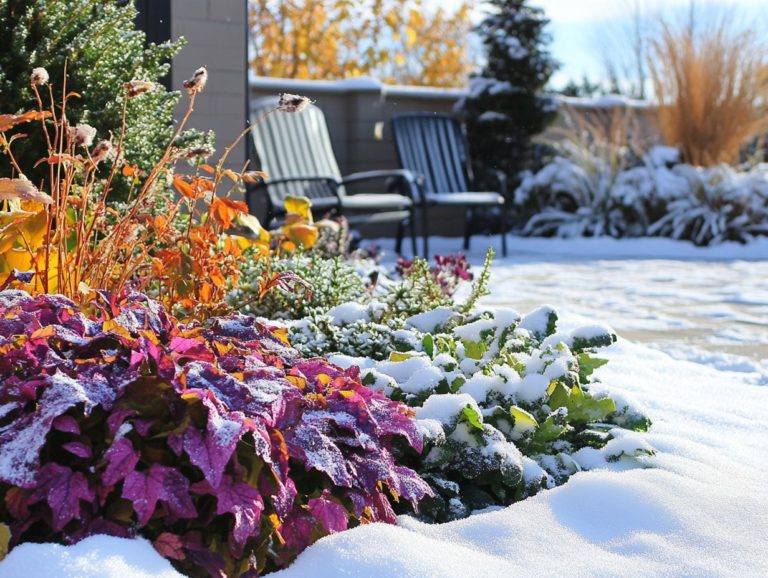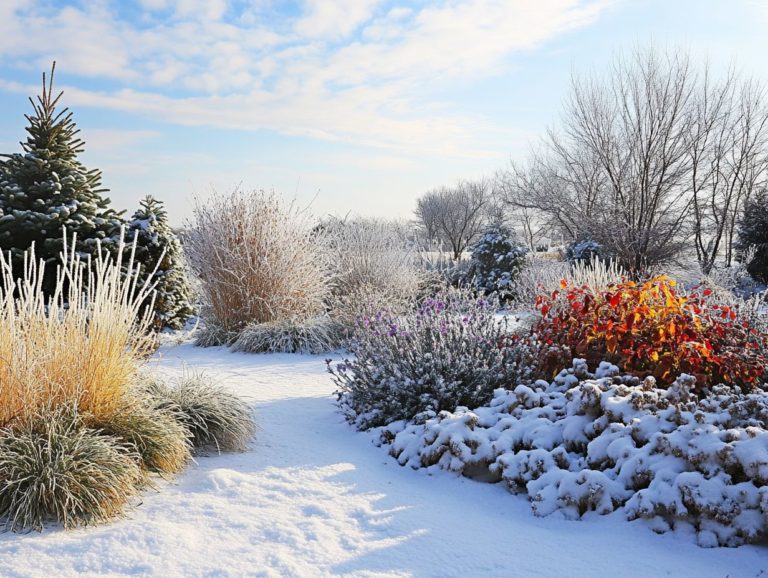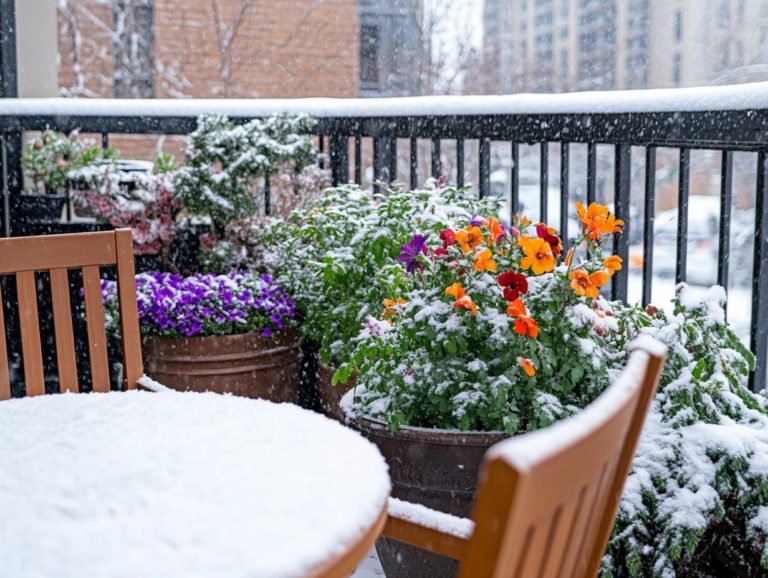Discovering Cold-Climate Fruit Trees
Cold-climate fruit trees present an exceptional opportunity for you to cultivate delicious, fresh produce right in your backyard, even in chillier regions.
These resilient trees flourish in less-than-ideal weather and provide numerous benefits to both you as a gardener and the local ecosystem.
Delve into popular varieties of cold-climate fruit trees, including unique apple types like Honeycrisp and Gala. Learn how to choose the best options for your garden while uncovering essential gardening tips for nurturing and maintaining them.
Transform your outdoor space into a fruitful haven that enhances both your home and the environment!
Contents
- Key Takeaways:
- Benefits of Growing Cold-Climate Fruit Trees
- Popular Types of Cold-Climate Fruit Trees and Resilient Fruit Trees
- How to Choose the Right Cold-Climate Fruit Trees for Your Garden
- Tips for Growing and Maintaining Cold-Climate Fruit Trees
- Frequently Asked Questions
- What are cold-climate fruit trees?
- What are some examples of cold-climate fruit trees?
- Can I grow cold-climate fruit trees in any climate?
- How can I determine if a fruit tree is suitable for my cold climate?
- Do cold-climate fruit trees require special care?
- Are there any benefits to growing cold-climate fruit trees?
Key Takeaways:
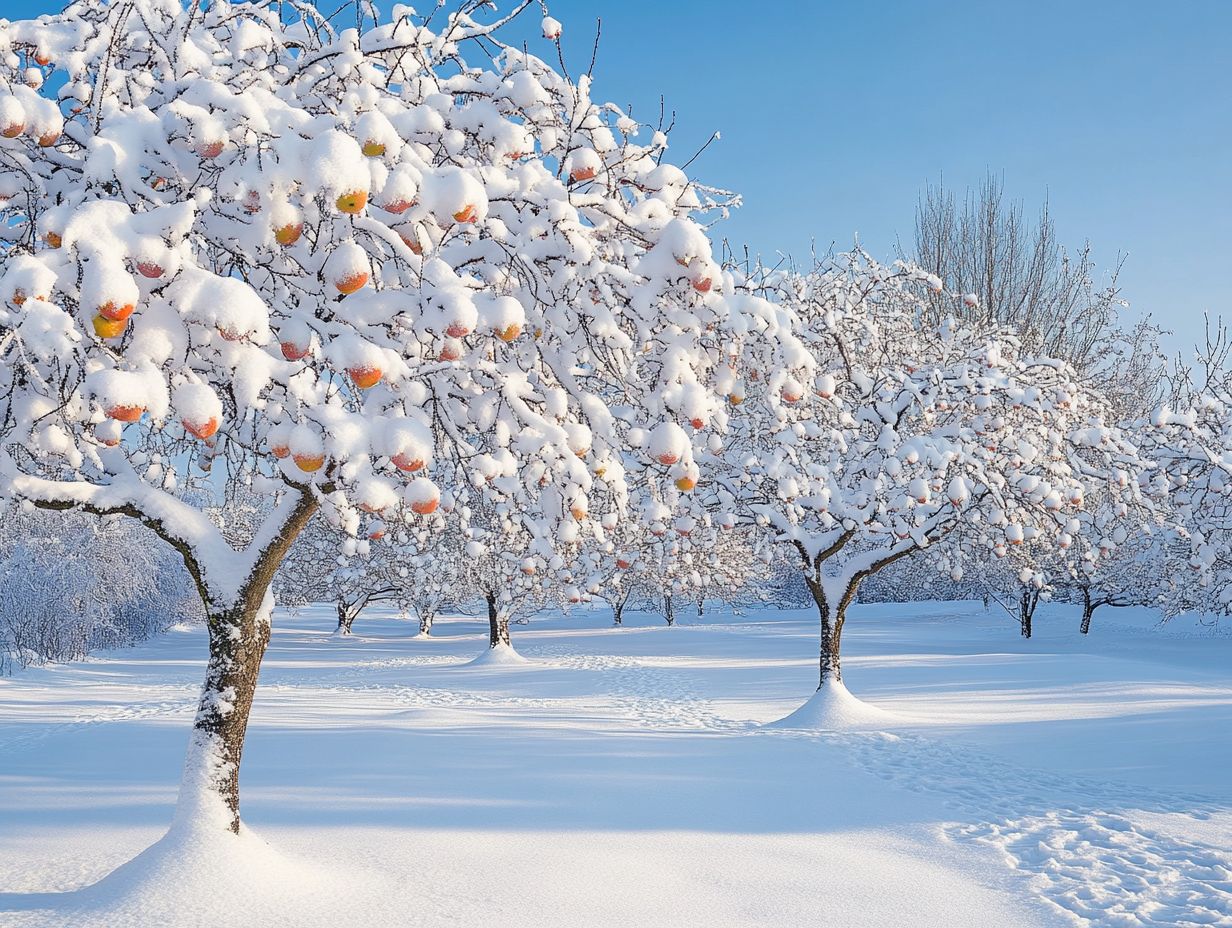
- Cold-climate fruit trees offer unique benefits to both gardeners and ecosystems, making them a valuable addition to any garden.
- When choosing the right cold-climate fruit trees, consider factors like hardiness, pollination needs, and available space.
- Proper care and maintenance are essential for the optimal growth and production of cold-climate fruit trees.
Discover Cold-Climate Fruit Trees!
Cold-climate fruit trees are a fantastic choice if you’re facing the challenges of harsh weather in northern climates. For more information, consider selecting trees for cold-climate landscaping. These resilient varieties, such as those from the American Fig Company, showcase impressive pest and disease resistance. This ensures that your fruit production thrives even under difficult growing conditions.
To create a flourishing fruit-bearing landscape in colder regions, it’s essential to understand the characteristics and requirements of these trees. Climate zones significantly influence which fruit tree varieties will succeed.
Originating from colder regions, these fruit trees think apples, pears, and cherries are equipped to withstand frost and snow. They thrive where many other species struggle. Their survival through harsh winters hinges on factors like soil quality, moisture levels, and sunlight exposure.
Cold-climate fruit trees offer a wide range of hardiness, making them versatile options for your gardening ambitions. To learn more about the best cold-climate fruits to grow, they allow you to cultivate a rich and diverse ecosystem.
Incorporating these resilient varieties enhances local biodiversity and enables you to enjoy delicious fruits with minimal reliance on pesticides or heavy treatments. Their natural resistance to common pests and diseases leads to a more sustainable gardening experience, allowing you to savor the fruits of your labor with peace of mind.
Benefits of Growing Cold-Climate Fruit Trees
Growing cold-climate fruit trees presents a wealth of advantages. You can savor delightful yields while elevating your garden space with stunning blooms and lush foliage all while embracing a food forest approach. These trees boost your garden’s ecosystem, making it vibrant and alive!
Explore unique apple varieties and other fruits like peaches and figs that thrive in northern climates. Enrich your gardening journey with every season.
Start your journey with cold-climate fruit trees today!
Advantages for Gardeners and Ecosystems
The benefits of growing cold-hardy fruit trees go well beyond just enjoying delicious harvests; they play a vital role in enhancing ecosystems and providing resources for pollinators. By incorporating these trees into your garden spaces, you can create a sustainable environment that supports wildlife while reveling in the variety of fruits suited for northern climates. You’ll love adding unique apple varieties and resilient species like the Chicago Hardy Fig to your garden!
These trees enrich the biodiversity of your garden, offering habitat and nourishment for various beneficial insects and animals. When you choose diverse species, you not only elevate the visual appeal of your landscape but also promote healthy soil and strengthen ecosystems.
To get the most out of these benefits, consider planting a mix of trees, shrubs, and flowering plants to create a lively garden full of food. Techniques like companion planting and mulching can enhance soil health, while carefully placed flowering plants can attract essential pollinators, such as bees and butterflies, ultimately boosting your fruit yield and ensuring a flourishing garden.
This holistic approach nurtures a balanced ecosystem, supporting both the health of your garden and the local wildlife.
Popular Types of Cold-Climate Fruit Trees and Resilient Fruit Trees
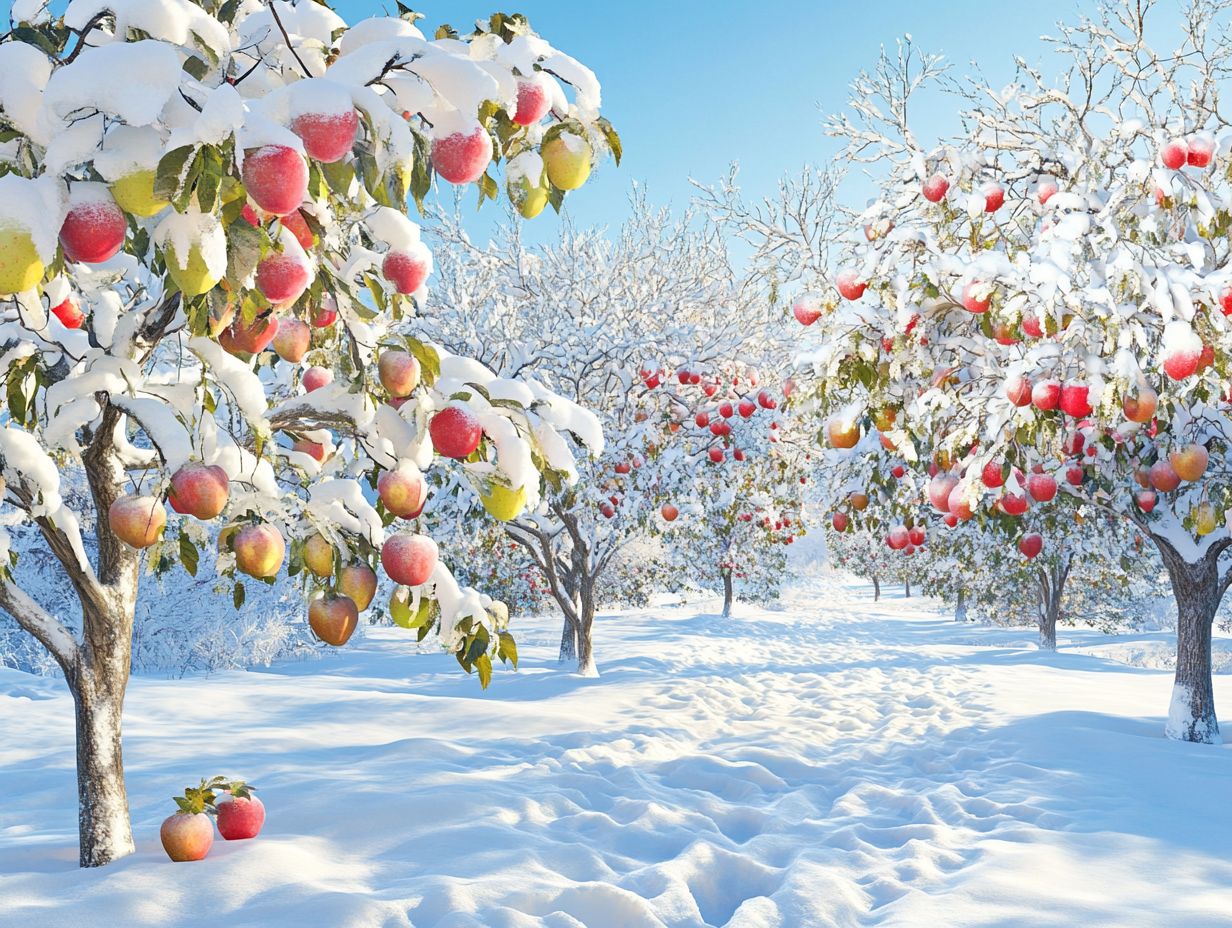
You’ll discover a range of popular cold-climate fruit trees that not only endure harsh conditions but also bring unique flavors and characteristics to elevate your garden. For more insights on this, check out how to grow cold-climate fruit trees, and consider adding varieties like Honeycrisp and Gala apples, alongside cold-hardy pears such as Bartlett and resilient cherries like Bing.
These have become go-to choices for gardeners aiming to cultivate delicious yields in northern climates. Distinctive cultivars like Reliance peach and Chicago Hardy fig are robust choices, enriching your garden with diversity and abundance.
Descriptions and Characteristics
Cold-hardy fruit trees possess unique characteristics that make them perfectly suited for colder climates, including impressive pest and disease resistance. Varieties like historical heirloom apples not only add an intriguing touch to your garden but also highlight the adaptability of these resilient trees. Knowing these traits helps gardeners boost fruit production and ensure healthy growth.
In colder regions, varieties such as Northern Spy and Gravenstein apples exhibit remarkable resilience, thriving in harsh winters while warding off common diseases like apple scab and fire blight. These cold-climate fruit trees often boast thicker bark and deep root systems, anchoring them against strong winds and allowing them to extract nutrients from the earth during shorter growing seasons.
Some varieties yield a greater harvest when cross-pollinated (when pollen from one plant fertilizes another), promoting diversity in your orchard. Additionally, fruits like hardy cherries and berries, including currants and gooseberries, not only display beautiful blossoms but also deliver a rich bounty of flavor, making them equally desirable for home gardeners eager to cultivate a lasting and productive landscape.
How to Choose the Right Cold-Climate Fruit Trees for Your Garden
Selecting the ideal cold-climate fruit trees for your garden requires a thoughtful approach. Begin by familiarizing yourself with hardiness zones (the climate zones that indicate which plants can thrive in specific temperatures), then assess your specific growing conditions and the space you have available.
Each type of tree comes with its own distinct pollination needs and growing preferences, which must harmonize with your local climate to achieve successful cultivation. For instance, certain unique apple varieties flourish in colder weather, while others may struggle. Making informed decisions is crucial to maximizing your fruit production and ensuring a bountiful harvest.
Don t miss out on the chance to enhance your garden!
Factors to Consider
When you re selecting cold-hardy fruit trees for your garden, several key factors come into play, including hardiness zones, specific growing conditions, and the space available in your garden.
Each of these elements significantly impacts the success and longevity of your trees. Understanding the specific needs of each variety, such as their resistance to pests and diseases, is essential to choose trees that will truly thrive in your unique environment.
This knowledge not only paves the way for a bountiful harvest but also helps minimize maintenance challenges.
- First, familiarize yourself with hardiness zones. These defined areas indicate which types of trees can withstand winter temperatures in your region.
- Next, evaluate your specific growing conditions, like soil quality and drainage, to pinpoint the most suitable trees for your plot. Choosing varieties that align with your region’s climate will enhance growth and fruit production.
Consider how important pest and disease resistance is. Choosing strong varieties helps you use fewer chemicals, transforming your gardening experience into a more sustainable and enjoyable endeavor.
By taking all these factors into account, you ll be enabled to create a thriving environment for your chosen fruit trees.
Tips for Growing and Maintaining Cold-Climate Fruit Trees

Growing and maintaining cold-hardy fruit trees demands a blend of thoughtful gardening strategies and techniques to guarantee best growth and fruitful yields.
For example, employing proper pruning methods can significantly improve air circulation and sunlight exposure, creating an ideal environment for your trees.
Choosing late-blooming types can help avoid problems with late frosts often encountered in colder regions.
By grasping the specific needs of each tree type, including their resilience to cold climates, you set the stage for successful fruit tree cultivation in northern climates, paving the way for a bountiful harvest.
Best Practices for Optimal Growth
To achieve the best growth of your cold-hardy fruit trees, using best practices is key to your success!
This includes effective gardening tips tailored to your specific growing conditions and the environmental challenges you face.
Proper soil management is crucial for nurturing robust root systems. Well-drained, nutrient-rich soils can significantly enhance the vigor of your trees.
Regular soil testing allows you to identify nutrient deficiencies, enabling timely amendments that support overall health.
Thoughtful watering strategies especially during dry spells can prevent stress and foster strong fruit development.
These practices not only protect your trees from pests and diseases but also boost their yield and quality, leading to a fantastic harvest!
By adopting these methods, you can cultivate a thriving ecosystem where your cold-climate fruit trees flourish, even in the face of harsh conditions.
Frequently Asked Questions
What are cold-climate fruit trees?
Cold-climate fruit trees are varieties of fruit trees that are adapted to grow in regions with colder climates, usually with temperatures below freezing in the winter.
What are some examples of cold-climate fruit trees?
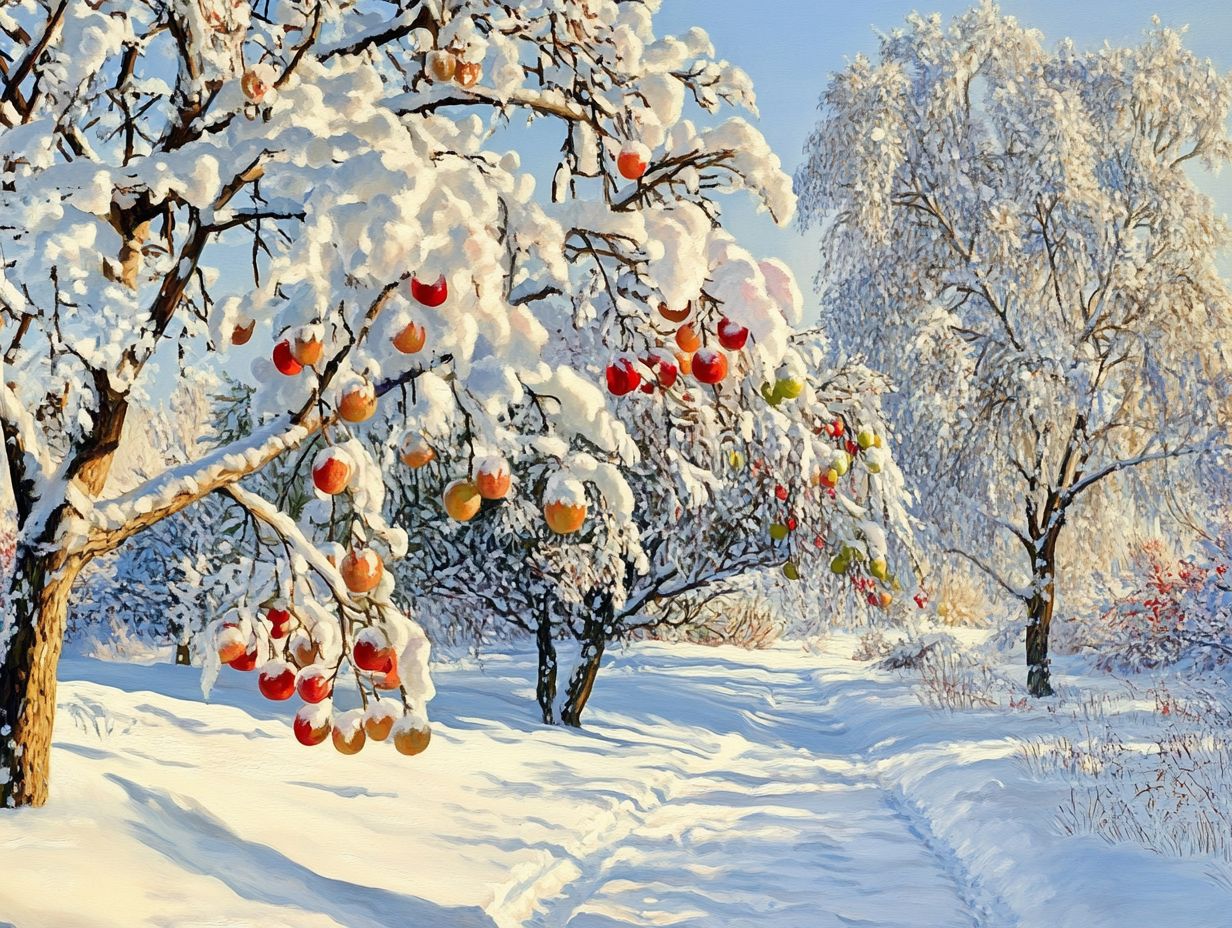
Some examples of cold-climate fruit trees include apples, pears, plums, cherries, and apricots. These trees are able to withstand colder temperatures and still produce fruit.
Can I grow cold-climate fruit trees in any climate?
No, cold-climate fruit trees are specifically suited for regions with colder temperatures. They may not thrive or produce fruit in areas with warmer climates.
How can I determine if a fruit tree is suitable for my cold climate?
You can research the specific hardiness zone and temperature requirements for the fruit tree you are interested in. Additionally, seek advice from local garden centers or extension offices.
Do cold-climate fruit trees require special care?
Cold-climate fruit trees need extra attention during winter. Wrapping or covering them protects them from frost and snow.
You will also need special pruning methods to ensure a healthy fruit harvest.
Are there any benefits to growing cold-climate fruit trees?
Yes, definitely! Growing these trees adds diversity to your garden and lets you enjoy delicious, homegrown fruit.
These trees also support local ecosystems and agriculture. Don’t miss out on the chance to elevate your garden!


